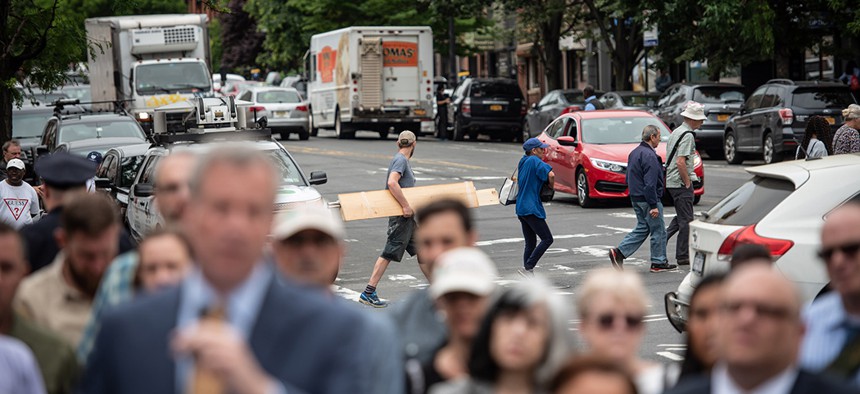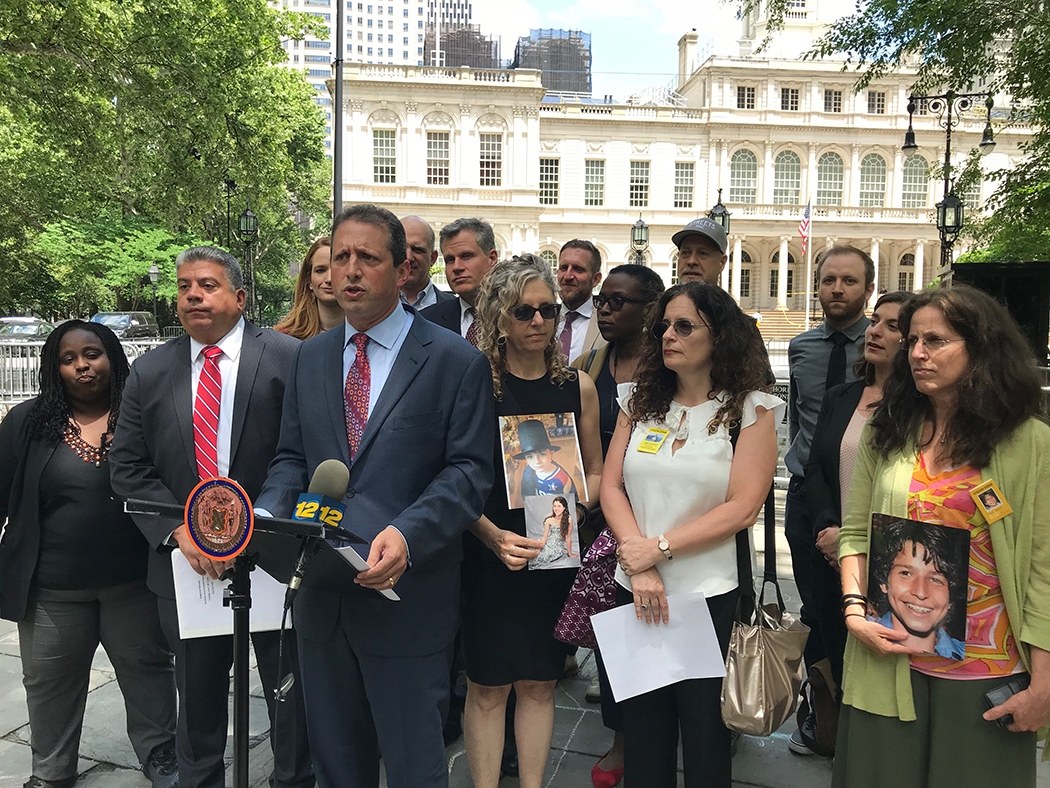New York City
Brad Lander wants to give traffic cameras teeth. Will Albany allow it?
New York City politicians want to strengthen cameras – while the state Legislature may not even renew their authorization.

Traffic behind New York City Mayor Bill de Blasio's press conference announcing a redesign of 9th St. in Park Slope and calling for speed-camera expansion. Michael Appleton/Mayoral Photography Office
In response to a deadly March car crash in Brooklyn in that took the lives of two children and a fetus when Dorothy Bruns allegedly lost control of her car, New York City Councilman Brad Lander proposed a bill that would give the city the power to intervene with drivers who rack up tickets from speeding and red light cameras in school zones. Brooklyn District Attorney Eric Gonzalez and street safety advocates hailed the bill for closing a loophole whereby dangerous drivers are currently left behind the wheel if their speeding is caught by cameras rather than cops. Given Mayor Bill de Blasio’s commitment to reducing pedestrian fatalities, one might expect this bill to sail through the City Council.
But, as with so many of New York City’s affairs, this would require approval from the state Legislature: Albany would first have to reauthorize funding for the city’s speed cameras, which may not even happen at all.
At a press conference in City Hall Park on June 5, Lander introduced what he’s calling the Reckless Driver Accountability Act, a three-pronged measure to punish drivers who are repeatedly ticketed by city traffic cameras. The bill includes a requirement that the city annually study dangerous driving in order to determine what behavior is most likely to cause a fatal or injurious car crash. The bill also would expand a restorative justice program, which puts reckless drivers through counseling and education in lieu of jail time in an effort to change their habits, and would allow the city to boot or impound cars that get five or more traffic camera tickets in a single year.
The inspiration for Lander’s bill is in part the fact that Bruns had racked up five speeding and red light tickets from traffic cameras in a two-month period in 2017. Had the law already been in place, Bruns’ car would have been booted or impounded and the children run over by Bruns in Park Slope, within Lander’s district, might still be alive today.
“There's really hard evidence that putting cameras in front of the schools reduces speeding and reduces crashes,” Lander said at the press conference, referring to a city Department of Transportation report from 2017 that showed a 63 percent decrease in speeding violations and a 15 percent reduction in crashes in school zones that have the cameras.

While Lander’s logic might appeal to most members of the City Council, the city’s current traffic camera program in school zones was made possible by Albany legislation five years ago, and was specifically set up to sunset this year.
While New York City might be less car-oriented than anywhere else in the United States, in the state government, cars and drivers reign supreme. With just seven days left to go in the legislative session, a bill sponsored by state Sen. Jose Peralta that would double the number of school zones covered by the cameras is stuck in the Senate Cities Committee, which is currently chaired by shadow governor Simcha Felder. Felder says Peralta’s bill will only pass if his own bill requiring armed officers in front of every city school, a longtime dream of Felder’s, gets Senate approval as well.
Felder – who caucuses with the Republicans, even though he is a Democrat – has a long history of opposing traffic safety cameras and holding legislation pertaining to them hostage to his unrelated fixations. (In 2013, he obstructed the installation of speeding cameras, but then offered to reverse his stance if the city picked up the tab for yeshiva school buses.)
While speed cameras tend to break down on partisan lines, with Democrats in support and Republicans opposed, Peralta’s bill could have enough votes to pass the Senate if the bill makes it to the floor. It has picked up a pair of Republican co-sponsors: Patty Ritchie and Marty Golden, a Brooklyn Republican from a neighboring district who often works together with Felder and was against the introduction of traffic cameras in 2013.
Another layer of unpredictability is added by the state Senate having been stuck over the last two weeks in a 31-31 stalemate due to the absence of Republican Sen. Tom Croci, who has been away on military leave. With Republicans controlling the calendar but facing the threat of hostile amendments from the Democrats – who could win votes 32-31 with Lt. Gov. Kathy Hochul breaking the tie – the GOP decided to avoid putting anything on the floor at all.
Temperatures in the body have cooled, though, and with just a week remaining in the legislative year, the parties hashed out a deal in which Democrats backed off trying to use their temporary numerical majority to get things moving again.
No one is attempting to derail the remainder of the session by pushing too hard, meaning the extender legislation could stall until next year.“My gut is it gets a straight extender, I think that's the minimum,” a Senate communications source told City & State, who spoke on the condition of anonymity because they weren’t directly part of legislative negotiations.
There has been an intensive effort to expand the number of school zones covered by traffic cameras from 140 to 290, with de Blasio, Lander and other public officials calling on the state Legislature to expand the program at a previous appearance in Park Slope to announce safety changes to the street where the accident occurred. There was also a rally for the bill in front of Gov. Andrew Cuomo’s Manhattan office last week, which got a visit and endorsement from Cuomo’s lead counsel Alphonso David and Secretary to the Governor Melissa DeRosa. The governor’s office did not respond to an inquiry as to whether, if the traffic camera program is in danger of lapsing at the end of the current session, Cuomo would call a special session to ensure the program is extended.
De Blasio spokesperson Seth Stein told City & State the mayor’s office is reviewing the Lander legislation, and brought up his support for the bill sponsored by Peralta, who represents a district in Queens. “The mayor shares the goal of getting dangerous drivers off our streets, which is why we are supporting a package of legislation in Albany that would do just that,” said Stein.
While Lander sounded somewhat exasperated at Albany’s meddling, at the June 5 press conference he also predicted that the speed camera program would still exist by the end of this year’s session. “If Albany creates even more gaps by failing to put cameras in front of every school, or if they even fail to reauthorize even the existing program, they're putting the lives of their constituents and all New Yorkers in harm's way,” he said. “And I'm optimistic New York won't let that happen.”

